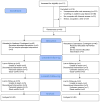Nationwide access to an internet-based contingency management intervention to promote smoking cessation: a randomized controlled trial
- PMID: 27923264
- PMCID: PMC5382065
- DOI: 10.1111/add.13715
Nationwide access to an internet-based contingency management intervention to promote smoking cessation: a randomized controlled trial
Abstract
Background and aims: Contingency management (CM) is one of the most effective behavioral interventions to promote drug abstinence, but availability of this treatment is limited. We evaluated the efficacy and acceptability of internet-based CM relative to an internet-based monitoring and goal-setting control group in a nationwide sample of cigarette smokers.
Design: Randomized controlled trial with 3- and 6-month follow-ups.
Setting: United States.
Participants: Smokers (n = 94) from 26 states were enrolled (mean age 36, 56% female).
Intervention and comparator: Participants were randomized to earn financial incentives (up to $480 over 7 weeks) based on video-verified abstinence using breath carbon monoxide (CO) output (n = 48; abstinent contingent group, AC), or based on submitting CO samples (n = 46, submission contingent, SC). Both groups also received the same CO-based goals. A $50 deposit was required in both groups that could be recouped from initial earnings.
Measures: The primary outcome was point prevalence at week 4. Secondary outcomes were point prevalence at the 3- and 6-month follow-ups, percentages of negative CO samples, adherence to the CO sampling protocol, and treatment acceptability ratings on a 0-100-mm visual analog scale.
Findings: Abstinence rates differed at 4 weeks between the AC (39.6%) and SC (13.0%) groups [odds ratio (OR) = 4.4, 95% confidence interval (CI) = 1.6-12.3], but not at the 3- (29.2% AC and 19.6% SC, OR = 1.7, 95% CI = 0.6-4.4) or 6- (22.9% AC and 13.0% SC, OR = 2.0, 95% CI = 0.7-5.9) month follow-ups. During the two main treatment phases, there were significant differences in negative COs (53.9% AC and 24.8% SC, OR = 3.5, 95% CI = 3.1-4.0; 43.4% AC and 24.6% SC, OR = 2.3, 95% CI = 1.6-3.4). Adherence to the CO submission protocol was equivalent (78% AC and 85% SC, difference = 7.0%, 95% CI = -10.3 to 23.8 %, F < 1, P = 0.39). The lowest acceptability ratings were for the items assessing the deposit, whereas the highest ratings concerned the ease of the intervention, the graph of CO results, and earning money.
Conclusions: A contingency management/financial incentive program delivered via the internet improved short-term abstinence rates compared with an internet program without the incentives.
Keywords: Cigarette smoking; contingency management; deposit contract; financial incentives; technology; treatment.
© 2016 Society for the Study of Addiction.
Conflict of interest statement
None.
References
-
- Lim SS, Vos T, Flaxman AD, Danaei G, Shibuya K, Adair-Rohani H, et al. A comparative risk assessment of burden of disease and injury attributable to 67 risk factors and risk factor clusters in 21 regions, 1990–2010: a systematic analysis for the Global Burden of Disease Study 2010. Lancet. 2012 Dec 15;380(9859):2224–2260. - PMC - PubMed
-
- U.S. Department of Health and Human Services. The Health Consequences of Smoking—50 Years of Progress: A Report of the Surgeon General, 2014. U S Department of Health and Human Services, Centers for Disease Control and Prevention, National Center for Chronic Disease Prevention and Health Promotion, Office on Smoking and Health; 2014.
Publication types
MeSH terms
Substances
Grants and funding
LinkOut - more resources
Full Text Sources
Other Literature Sources
Medical


